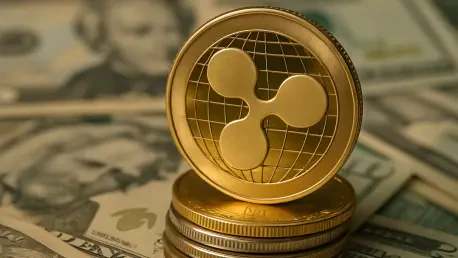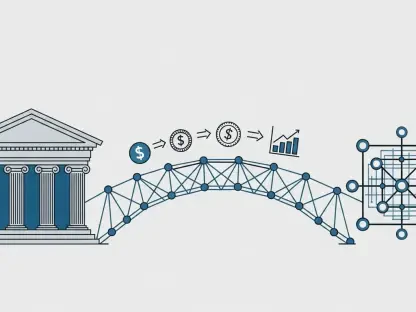As the cryptocurrency landscape experiences dramatic shifts in 2025, XRP emerges as a beacon of change, capturing the attention of investors and analysts alike. Mid-year figures reveal an astounding ascent as XRP crosses the $3.43 threshold, echoing heights last seen in 2018 and catapulting its market capitalization to a formidable $207 billion. Standing as the third most valuable digital asset, this rise is more than just speculative mania; it highlights a nuanced transformation driven by legislative clarity, heightened institutional participation, and evolving market dynamics. The underlying currents propelling XRP’s valuation are setting a new course for digital currencies, influencing perceptions from Wall Street to Main Street.
Legislative Clarity: A Catalyst for Change
The Impact of Regulatory Frameworks
The introduction of the GENIUS Act and the CLARITY Act in 2025 by the U.S. legislative arm marks a significant turning point in the regulatory environment for cryptocurrencies, most notably for XRP. These landmark statutes addressed long-standing ambiguities that plagued digital currencies. For XRP, the CLARITY Act distinguished securities from commodities, resolving its status and laying the foundation for secure operations within the U.S. financial system. The requirements of the GENIUS Act further ensured that stablecoins conformed to federal standards, transforming XRP-related financial products into safe investment avenues. This newfound clarity not only resolved XRP’s legal predicaments but also invigorated investor confidence, fostering a more stable trading environment.
The approval of a stablecoin under federal guidelines has invigorated Ripple’s RLUSD, positioning it as an attractive option for volatility-wary institutional investors. Embracing these frameworks allowed Ripple to build trust and demonstrate adherence to compliance, fostering an ecosystem where digital assets like XRP can thrive. Whether for corporate treasuries or individual investors, a legally secure landscape is imperative for the longevity and growth of cryptocurrencies. These legislative clarifications embody a noteworthy progression towards a fully compliant digital economy, bridging gaps between traditional financial operations and modern blockchain applications.
Political Backing and Institutional Enthusiasm
The movements in regulatory frameworks were further supported by a political landscape that favored crypto innovations. The advocacy from key political figures, including President Trump and Scott Bessent, underscored a commitment to a pro-innovation and crypto-neutral environment. Investors noticed an easing of legal threats, further buoyed by the positive sentiment from Polymarket’s 85% approval probability for spot XRP ETFs. This environment resembles the anticipation witnessed during Bitcoin ETF approvals, rounding off a year of optimism.
Institutional investments have been pivotal in XRP’s upward trajectory. The involvement of key corporations like Ribbit and Webus, contributing over $421 million, mirrors earlier movements in Bitcoin by firms like MicroStrategy. These decisions mark XRP as a strategic reserve asset, underscoring its future value stability. Ripple’s bid for a U.S. banking license represents another strategic leap, integrating traditional banking structures with blockchain capabilities. By utilizing products like xRapid and xCurrent, XRP is poised to become a cornerstone for cross-border transactions, addressing a sizable chunk of the $2.5 trillion market demand for more efficient solutions.
Dynamic Market Sentiment and Institutional Adoption
On-Chain Dynamics and Whale Accumulation
Institutional intrigue is mirrored by enhanced on-chain dynamics, which demonstrate healthy engagement from both corporate and individual investors. Notably, whale activities have surged, with major holders acquiring an additional 2.2 billion XRP over recent weeks. This spike is reminiscent of Bitcoin’s previous rallies, suggesting similar potential for value escalation. The lucrative possibility of XRP’s growth is underscored by Santiment’s MVRV golden cross, indicating rare undervaluation signals that lend further credibility to the asset’s bullish narrative.
Moreover, the explosive growth in XRP wallet bases reflects burgeoning retail interest. A 200% increase in new accounts attests to the widening base of XRP proponents. Initiatives like Ripple’s EVM-compatible sidechain and the freshly launched ProShares XRP ETF have democratized investment approaches, drawing mainstream participation. These developments amplify the narrative of institutional approval and individual acquisition, fortifying XRP’s emergent position in the crypto sphere. The ETF alone attracted assets worth $1.2 billion within a week, highlighting the appetite for structured, regulated exposure to XRP.
Technical Prospects and Potential Risks
Technically, XRP’s trajectory showcases promising developments. The breakout from a multi-year symmetrical triangle has ignited a significant price uptick, epitomized by a 25% weekly gain. Present analyses place short-term targets around $3.85 to $4.00, a nod to 2018’s peaks, while ETF-induced adoption could propel prices even higher to $5.50–$7.00 as the year draws to a close. Looking further afield, acquiring a banking license might elevate XRP’s status, possibly leading to valuations between $8 and $10 in the subsequent years. However, potential pitfalls still exist.
Exchange inflow patterns suggest possible profit-taking actions, posing a risk of reverting to a $2.90–$3.00 range if XRP fails to stably breach current thresholds. Additionally, broader concerns such as Bitcoin’s market equilibrium and regulatory backtracking cast shadows over its continued prosperity. Strategic timing is crucial—short-term traders might capitalize on ETF-driven liquidity, while those in for the long haul should heed Ripple’s banking aspirations and cross-border transaction initiatives, diversifying investments with an eye on optimizing both yield and safety.
Navigating a New Financial Terrain
In 2025, the realm of cryptocurrencies undergoes significant transformations, with XRP emerging as a central figure of progress and attracting extensive interest from both investors and analysts. By mid-year, XRP impressively surpasses the $3.43 mark, a level not observed since 2018, catapulting its market cap to a staggering $207 billion. Establishing itself as the third most valuable digital currency, this increase reflects more than mere speculative fervor; it marks a sophisticated evolution influenced by clearer regulations, increased institutional involvement, and shifting market dynamics. These factors are driving XRP’s valuation and reshaping the trajectory of digital currencies, impacting attitudes on Wall Street and Main Street alike. XRP’s ascent symbolizes a significant pivot in the cryptocurrency world, demonstrating the crucial role legislative clarity and institutional engagement play, thereby ushering in new perceptions and possibilities for investors across the spectrum.









